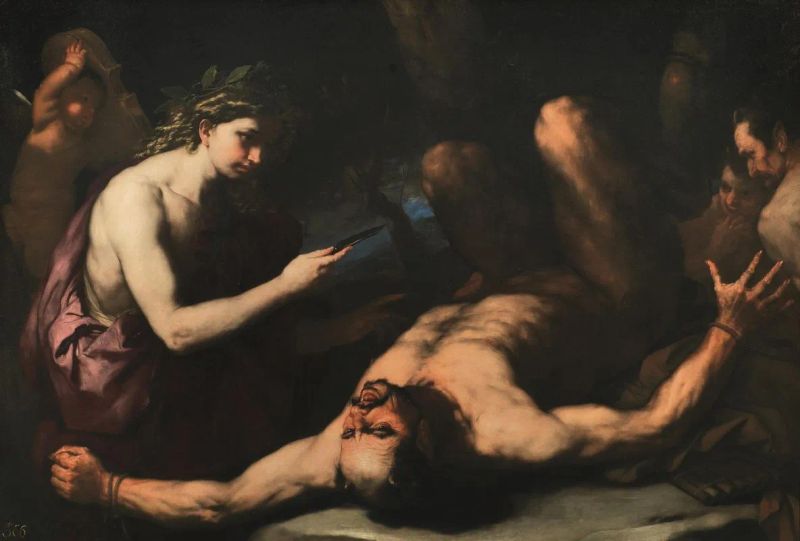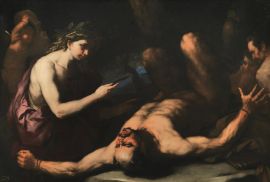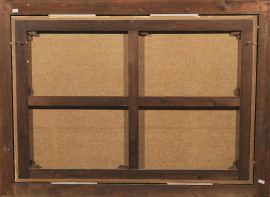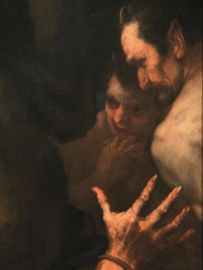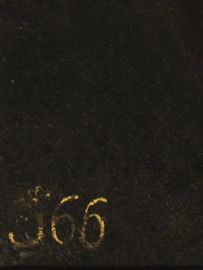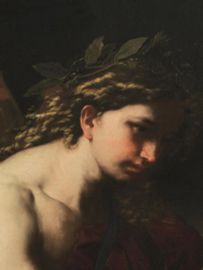Luca Giordano
(Napoli, 1634 – 1705)
APOLLO AND MARSYAS
oil on canvas, cm 125x180
inscribed lower left with an inventory number (366 or 566) in yellow paint
This early masterpiece by Luca Giordano comes up for sale nearly forty years after having been auctioned by Christie’s in London in 1988. Ever since, it has been kept in an Italian private collection. Its previous history is still unknown, notwithstanding records of paintings of this subject attributed to Luca Giordano which were sold in London and in Paris from mid-eighteenth century until 1837 (see The Getty Provenance Index). Originally, it was certainly part of a large and important collection, as shown by the three-figure inventory number at the lower left corner, as well as by the sheer quality of the work itself.
When it first appeared on the art market, Nicola Spinosa pointed out a very close relationship between our painting and the celebrated Apollo flaying Marsyas by Jusepe de Ribera, a fully signed work of the Spanish artist, dated 1637, now in the Museo Nazionale di Capodimonte in Naples, from the d’Avalos collection (fig. 2): a painting where the poignant beauty of the Sun god associates with the sheer cruelty of his deed in a dramatic contrast typical of the Baroque age which Sebastian Schütze pointed out, in reference to our version of the subject.
The painting by Jusepe de Ribera was a source of inspiration for Luca Giordano through the 1650s. His first response to Ribera’s masterpiece was the large-sized Apollo and Marsyas in full figures, also in Capodimonte, from the collection of Principe di Fondi; another version, possibly from the 17th century Neapolitan collection of Ferdinand van den Eynden, is currently in an Italian private collection (fig. 5; see Luca Giordano 1634-1705. Catalogue of the exhibition, Naples 2001, nn. 44 and 45).
Several details in both paintings come from Ribera, such as the crying satyrs in the background, assisting to Marsyas being tortured in punishment for defying Apollo’s musical excellence; the Sun god is also close to Ribera’s model in his golden hair and his pink, flying garment, but Giordano painted him in an attitude which is both more realistic and full of brutality.
In the foreground, the screaming Marsyas closely relates to the corresponding figure by Ribera and, generally, refers to a series of tormented mythological characters which the Spanish artist painted in the 1630s, such as Titius (Madrid, Prado) of 1632, and Prometheus, formerly in the Barbara Piasecka Johnson collection, with Sotheby’s in London in July 2009 (fig. 4).
Smaller in size but equally imposing, our painting depicts the moment just preceding the chastisement: crowned by a laurel wreath stating his divine nature, Apollo affects a pensive mood, as if marking the fairness of the impending punishment, which is not due to a god taking offence but, on the contrary, is fully legitimate. He holds a knife and prepares to flay his opponent, while gazing at him in a deadly silence, more disquieting than the horrible deed he is about to perform. Nothing has actually happened yet but the satyr, lying upon a stone reminiscent of a sacrifice altar, is already screaming. Lower right we can see the syrinx with which he challenged the god, whose musical instrument is held by a winged putto in the opposite corner.
Seen close-up, Luca Giordano figures look more imposing in this painting than in his previous versions of the subject, and convey a stronger, almost unbearable sense of reality. This scene might be considered a pagan version of the Martyrdom of St. Bartholomew, an equally cruel and disquieting subject, as seen in the riberesque painting by Luca Giordano with Christie’s, London, in July 2014 (fig. 3).
This third and last version of the story of Apollo and Marsyas has been generally dated at the end of the 1650s, and considered to be the conclusion of a new riberesque phase of Luca Giordano. In a few more years, in 1665, the Neapolitan artist would move to Venice, where his “dark” (riberesque) style would prove influent for many local artists (subsequently called “tenebristi”); among them, notably, Johann Karl Loth.
Biographical note
Luca Giordano was born in Naples in 1634. He probably trained with his father, also a painter, whose life and work are currently unknown. Among his youthful inspirational sources we should remind Northern Cinquecento prints, providing subjects he would rework with surprising results, and Jusepe de Ribera early naturalism. Giordano’s series of ancient philosophers come in fact from works of the Spanish artist, who was active in Naples until his death in 1652, while Ribera’s lighter and colourful style from the late 1630s was seminal for many paintings, among which three different versions of the story of Apollo and Marsyas painted by Luca Giordano during the 1650s, and for the later Socrates and Alcibiades (with Walpole Gallery, London). Travels to Rome and Venice acquainted Luca Giordano with works by Pietro da Cortona and Cinquecento Venetian painters, which prompted his conversion to the Baroque style, starting in the 1660s. During a prolonged stay in Florence in 1682, he painted in fresco the Corsini chapel in the Carmine, and started work on the bozzetti for the library and the gallery in palazzo Medici Riccardi, a masterpiece of his mature style. In 1692 he moved to Madrid, at the request of King Charles II, and for the next ten years he worked for the royal palaces and churches, painting in fresco in the monastery of Escorial, in the sacristy of the Toledo cathedral, in the Buen Retiro palace, as well as providing paintings for the royal collection and for the Spanish nobility. He was back in Naples in 1702, and worked until his death in 1705 in various churches and convents, notably in the Cappella del Tesoro (Treasury Chapel) in the Certosa di San Martino, actually his last masterpiece.

